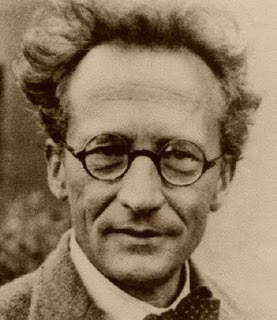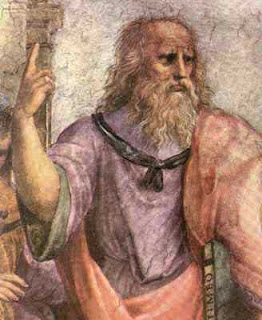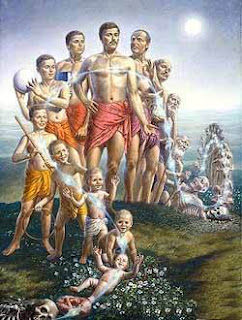"Science is the belief in the ignorance of experts."
Richard Feynman. "What is Science?"
The Physics Teacher Vol. 7, issue 6 (1969)
Richard Feynman. "What is Science?"
The Physics Teacher Vol. 7, issue 6 (1969)
"I think I can safely say that
nobody understands quantum mechanics."
Richard Feynman. The Character of Physical Law (1965)
~~~~
nobody understands quantum mechanics."
Richard Feynman. The Character of Physical Law (1965)
~~~~
SCHRÖDINGER'S CAT is one of the most famous thought experiments in the history of science. Erwin Schrödinger (left) used it to try to argue against adopting one approach Quantum Mechanics. Most people seem unaware that he was trying to highlight a problem with what was, in 1935, a controversial theory, but which has become the orthodoxy: namely the Copenhagen Interpretation of Quantum Mechanics . These days when we say Quantum Mechanics we usually mean the Copenhagen Interpretation of Quantum Mechanics (hereafter QM). Many people who know next to nothing about science, or about Schrödinger, have tried to co-opt Schrödinger's cat to show how there is a relationship between physics and Buddhism. Let me say at the beginning that I don't believe that there is any significant cross-over between physics and Buddhism, and that I hope to explain why in the rest of this post. Granted my degree is in chemistry and it was a long time ago; but I also studied physics, and I'm an ordained Buddhist, so I feel at least not-overly-unqualified to comment.
To begin with we need to be clear on scale. An atom is between 32 picometres and 225 picometres in diameter. A picometer is 1×10−12 m, i.e. a trillionth of a metre, or 0.000000000001 m. By contrast a human hair is around 50 µm or 0.000005 m. So a single hair is about about 1.5 million helium atoms in diameter. Basically this scale is unimaginable, so let's put it another way: if the diameter an atom was the thickness of a single sheet of copier paper (0.08mm) then a human hair would be 120 metres in diameter. Amedeo Avogadro showed that 12g of carbon contains approximately 6 x 1023 atoms of carbon. That is 600,000,000,000,000,000,000,000 (600 sextillion) atoms. If each carbon atom was 1 mm3 then the 12g of carbon would fill the Western Mediterranean Ocean (from Gibraltar to Sicily), with plenty to spare. In fact 12g of carbon (in the form of powdered soot) is about 2 teaspoons. In QM we're dealing with the subatomic world, with the protons, neutrons and elections, and the weirder particles which make up atoms. A proton is about 1/50th of the diameter of the smallest atom; while an electron is thought to be in the region of 10−22m, which is one 10-billionth the diameter of a proton. Don't be fooled by our ability to write these properties down in numbers: they are highly abstract, unimaginable, incomprehensible, and none of us can draw on experience to get a sense of them. If you are still confident that any of this is relevant to human existence then read on.
Those with an interest in this subject will know that QM conceives of subatomic particles as waves (which can behave like particles under some conditions) that are described not in terms of physical properties, but in mathematical formulas. QM is the first theory of science to not be based on observations of physical properties, but to emerge from abstract mathematical speculation. [ 1 ] Though of course QM makes testable predictions about the behaviour of matter on the picometer scale. This description of sub-atomic particles as waves has some interesting consequences. One is that the particle is not a point in space, but is smeared out over space. Another is that all we can know about the particles in atoms are the odds of the particle being in any one place in space at any given time. What's more, as Heisenberg showed, if we know precisely where a particle is, then we can't simultaneously know how fast it is going - this is called the Uncertainty Principle.
Schrödinger's thought experiment related to a curious prediction arising out of the mathematics of waves (subsequently experimentally confirmed). Under certain circumstances two wavy particles can become 'entangled' which means that their waves combine into a single system, though they retain their identities. (Don't worry if you don't quite understand how this works - Feynman was not being ironic when he said that no one understands QM.) Schrödinger's problem was that this meant that observing some of the properties of one of the particles, meant having certain knowledge about the other particle because the two must be in opposition. The main property we are concerned with is called 'spin' - which relates to the magnetic properties of charged particles.
The two entangled particles can be in one of two spin states, but cannot both occupy the same state. With regard to the spin state of any single particle we can only talk about the probability that they will be in a given state at any time until we observe it. However, observing the spin of one entangled particle, determines which state the other will be in with 100% certainty without observing it, no matter where it is in the universe. This appears to contradict the limit introduced by Einstein's Special Theory of Relativity (1905) that nothing, not even information, can travel faster than the speed of light. But also, and even more weirdly, before an observation we can only think about spin states in terms of probabilities and the the maths tells us that the combined probabilities of the two particles being in any given state always equals one. The Copenhagen Interpretation says that this effectively means that the two entangled particles are both in both states simultaneously - the two states are superimposed as the jargon goes.
This is quite counter-intuitive, but it has been a boon for science-fiction because the spin states of the entangled particles are linked no matter how far apart they are - "spooky action at a distance" as Einstein facetiously referred to it - which if you aren't too fussy about details gives you an excellent medium for instantaneous communications across the vastness of space.
However, it begs the question: how can something be in two states at once until observed? It was in order to highlight these paradoxical aspects of QM that Schrödinger put his imaginary cat in the imaginary box. With it he placed a mechanism which would release cyanide gas, with a switch triggered by the decay of an atom of Uranium, the timing of which we cannot predict from theory. Close the lid of the box, prime the switch and think: is the cat alive at this moment, or is it dead? If the atom has not decayed the cat will be alive, and if it has decayed the cat will be dead. We can't know until we open the box and observe. Schrödinger invited us to think of the cat as a metaphor for the infinitesimal sub-atomic particle, whose wave was metaphorically entangled with the Uranium atom. If the cat truly was like a sub-atomic particle, then it was both alive and dead until the box was opened, and it was observed to be one or the other. He was trying to show that this is a ridiculous conclusion, and that therefore the Copenhagen Interpretation must be flawed. He lost that particular argument.
A lot of people jump from the picometre scale to the metre scale without any thought for the consequences of a trillion-fold change in scale - even though we know, for example, that our bath water doesn't really behave like an ocean! Or though we know that those pre-CGI movie special effects with models are totally unconvincing. The problem is that in a real cat there are several thousand sextillions of atoms, made up of many particles. Although each infinitesimal particle is a wave and subject to QM effects, these are averaged out over some tens or hundreds of thousands of sextillions of particles. The behaviour of any one particle, or even any million or billion particles, is not going to change the average properties of the cat. Unlike sub-atomic particles, cats simply do not wink in and out of existence; they are not smeared out over space (except perhaps when run over); and we can in fact know quite precisely (compared to the size of the cat) where a cat is and how fast it is moving at the same time. The Uncertainty Principle doesn't apply on the macro level. QM has almost no relevance to the macro world, to a world where objects are made up of septillions of atoms because of the averaging effect of so many particles - if weird stuff was happening we'd never know because a human hair is millions of atoms in diameter. And this is partly why Schrödinger was unable to undermine the Copenhagen Interpretation with this thought experiment, and why it has been co-opted by the targets of his critique, not to mention Buddhists! Actually sub-atomic particles are not alive and it is not ridiculous to argue that they can be in two superimposed states at once, even though it is ridiculous to argue it for a cat. In effect, Schrödinger's Cat proved nothing.
One of the unfinished tasks of modern physics is finding some way to marry QM with Relativity (E=mc2 yadda yadda again we don't really understand this). This has proved elusive, though work is going on at both the empirical and the theoretical ends of the problem. So far no one has unequivocal evidence for, say, quantum gravity; and no one has been able to make the maths add up. It may in fact turn out that the two theories are not adequate to the task and that both will be subsumed into some larger construct (some people claim that String Theory will do it, if anyone can ever solve the equations; Stephen Hawking barracks for M-Theory if anyone can both figure out what equations are and how to solve them). Certainly dark matter and dark energy are causing a scramble to rework the Standard Model of Cosmology to account for the observations that gave rise to those terms. Often theories don't survive being scaled up by a dozen orders of magnitude, and this is the case for QM (so far).
It's pretty clear that QM, a mathematical abstraction, doesn't apply to our macro world. However it does have indirect consequences for us as QM issues have to be taken into account in designing new micro-processors which pack millions of transistors into square millimetres; and in nascent nano-technology. But in terms of our daily lives none of the observations of sub-atomic particles apply. None. The similarity of vocabulary is superficial and coincidental, just as the similarity of ethical jargon in various religions is largely superficial and coincidental! well, perhaps not entirely coincidental because like Schopenhauer, both Schrödinger and Niels Bohr were interested in so-called 'Eastern philosophy' and built some of it into the narrative.
Some weeks ago now, in the comments to my post on Rebirth and the Scientific Method Elisa and Krishna were asking: "why do Buddhists feel the need to justify their beliefs by appealing to science?" Part of my answer related to the way the scientific paradigm has dominated our lives for roughly 150 years. Science is incredibly successful in describing the physical world, and predicting new observations and properties of matter. Just look at the recent crop of Nobel Prizes to see the contribution that science makes. In a way it's obvious that we'd want to participate in that. It is a bit ironic that so few Buddhists are educated in the sciences, and tend to approach science with a mixture of abhorrence for perceived materialism, and credulous wonder at its success and authoritativeness.
I don't see much advantage in invoking the talisman of science in defence of religion, especially when on the whole we religieux are so ignorant of science (one of my teachers recently mentioned the way "larger bodies attract smaller ones" in a public talk. He's not an idiot, nor spiritually shallow, but he is clearly, painfully ignorant of science!). It so happens that Buddhists avoid some of the pitfalls of the modern world view (we don't have creation stories for instance), but though monotheism more obviously runs foul of science, I don't think we can sustain our traditional eschatologies, nor claims of ESP powers, nor to know the nature of 'reality', if we are working in a scientific paradigm. It's a minefield.
I don't think Buddhism on its own terms needs any scientific apologetic. Buddhism is originally the product of Iron Age India, and has adapted to many different cultural environments and world-views because, in my opinion, it is not so concerned with the realm of physics, it is concerned with the realm of the mind. Physics provides us with a far superior description of the physical world; but equally in the domain of the mind, and especially the problem of suffering, that Buddhism is far superior descriptively and practically (in terms of practices for working on the mind). This superiority in its own field is not a consequence of levels of technology or an understanding of physics. It's to do with observing our own minds. We don't need a Large Hadron Collider for this. We just need to sit quietly and observe our minds. It is a kind of empiricism, but we don't need to get caught up in making a 'science' out of it.
~~ oOo ~~
Notes
- This feature of QM not deriving from observations of physical properties was recently the subject of an article in the New Scientist: Webb, Richard. 'Reality Gap' 21 August 2010, p.32-6. NS apparently subscribes to another uncertainty principle as the article title is quite changeable:
- on the cover - The Ultimate Quantum Paradox
- contents page - The Ultimate Paradox
- printed article - Reality Gap
- online article - Is quantum theory weird enough for the real world? [login required]
- ScienceDirect article database - Quantum Mechanics: The Reality Gap [login required].
(Note: Though I gather that Schrödinger loved women and a good party, I confess I'm not really sure whether he owned a cat. Some people claim that Schrödinger was a cat lover, and some that he was a cat hater, but I thought my title was catchy and ran with it. I hope my readers will allow me some poetic licence.)
image: Erwin Schrödinger (internet endemic, i.e. copied so many times that there is no longer a discernible source).
Feynman quotes from Wikiquote.
If you want to learn about Quantum Theory from one of the men who helped to develop it, then I can recommend these three lectures by Hans Bethe: Quantum Physics Made Relatively Simple. As the site says, the Prof is 93 years old and lecturing to the other residents at his retirement home.
Updates to this post



 The word
The word  The
The 